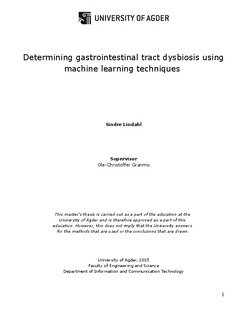| dc.contributor.author | Lindahl, Sindre | |
| dc.date.accessioned | 2015-09-11T07:57:37Z | |
| dc.date.available | 2015-09-11T07:57:37Z | |
| dc.date.issued | 2015 | |
| dc.identifier.uri | http://hdl.handle.net/11250/299472 | |
| dc.description | Masteroppgave informasjons- og kommunikasjonsteknologi - Universitetet i Agder, 2015 | nb_NO |
| dc.description.abstract | This thesis explores machine learning techniques for the purpose of determining gastrointestinal
tract dysbiosis. Dysbiosis is an unbalance of bacteria flora. Stool sample analysis of relevant
bacterias can be used in "diagnosis" of this condition. The problem is how to best classify
dysbiosis from a healthy balance of bacteria. Pattern recognition methods could be used to create
a diagnostic decision support system. The approach includes comparisons between classifiers with
the additional use of feature reduction techniques. Experiments show that the accuracy varies
significantly depending of which classifier is used. The best classifier for the data set used here was
found to be the C4.5 decision tree. Much of the analyzed data is shown to be noisy, confusing and
irrelevant to the classifier. Accuracy can be improved by reducing the amount of bacteria species
with more than 90%. In addition, results imply that the different microbial stool analysis panels
seriously affect accuracy. Which classifier to use and the highly relevant feature subsets found
should be helpful for any future work in the field of gut dysbiosis. And the comparisons could be
applicable for classification of similar data sets. | nb_NO |
| dc.language.iso | eng | nb_NO |
| dc.publisher | Universitetet i Agder ; University of Agder | nb_NO |
| dc.subject.classification | IKT 590 | |
| dc.title | Determining gastrointestinal tract dysbiosis using machine learning techniques | nb_NO |
| dc.type | Master thesis | nb_NO |
| dc.subject.nsi | VDP::Technology: 500::Information and communication technology: 550 | nb_NO |
| dc.source.pagenumber | 43 s. | nb_NO |
